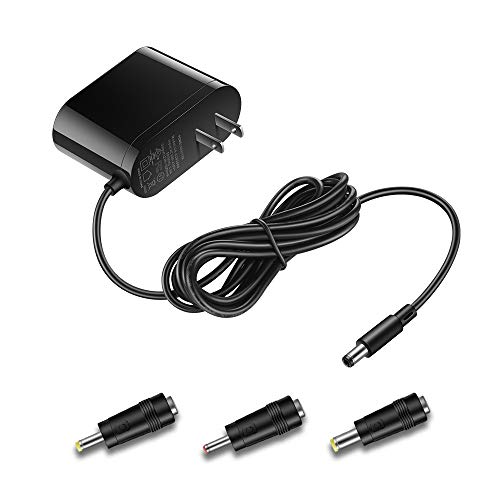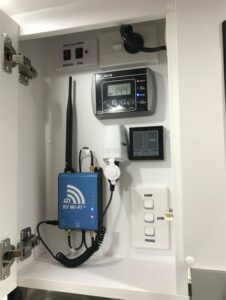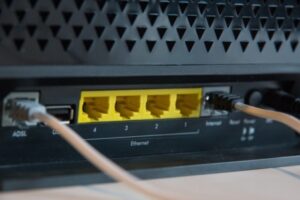The WiFi Scanner is a tool that helps detect visible wireless networks and delivers information on them. It provides the network name, signal strength, MAC address, channel, data rate, and so on.
Access point users and administrators usually use the scanner to determine the distribution of signal strength in a network. It is essential for optimizing the connection speed of a network and planning the security parameters for network safety.
Understanding the devices connected to your network is important. Through it, vulnerabilities or abnormalities can be easily fished out. Being able to monitor your network helps you implement proactive measures against future trouble.
Having visibility of connected devices allows you to enforce access controls more effectively.
- Compatible with major cable internet providers including Xfinity, Spectrum, Cox and more. NOT compatible...
- [Compatibility] 12V Power Supply Adapter Compatible with Netgear, Linksys, Asus,Motorola, Motorola/Arris...
Top WiFi scanners of 2024

1. Wireshark
Wireshark is an open-source packet analyzer. It is used with operating systems and other devices to analyze network traffic. It runs on BSD, Linux, macOS, Solaris, and other operating systems similar to UNIX.
It can be used for network analysis, software development, and troubleshooting. Its latest features include:
- Improved protocol support
- Enhanced filtering capabilities
- Compatibility with emerging technology
Wireshark uses display filters to transform data into a readable format and boasts compatibility with the most recent network technologies.
It provides enhanced support for a wide range of protocols. This provides a comprehensive and precise analysis across various network scenarios.
It can create modes that allow controllers to observe all visible traffic. This helps network administrators optimize network performance and strategically manage resources.
2. NetSpot
NetSpot is a versatile WiFi solution that can be used at home and professionally. It allows for the visual representation of WiFi signal strength and coverage areas.
It gives information like SSID, BSSID, signal strength, and frequency bands on the network. Getting the signal information makes it easy to get the best access point locations.
NetSpot is a versatile solution for analysis as it can run on both Windows and Mac operating systems. It can easily interact with hardware configurations and provides a consistent user experience.
It offers a user-friendly interface for evaluating network performance and optimizing setups. The predictive modeling features of NetSpot aid in network design by simulating possible situations. This helps users make better and more informed decisions.
3. Acrylic WiFi Home
Acrylic is a free WiFi scanner that can monitor wireless networks. It detects and displays connected devices’ access points and security measures. It can create passwords and collect data from 802.11/a/b/g/n networks.
The Acrylic WiFi suite offers various features, including heat mapping, network analysis, and wireless intrusion. An easy-to-use interface assists users, IT specialists, and wireless engineers. It is useful in visualizing, monitoring, and optimizing wireless networks.
4. inSSIDer
inSSIDer is also used to measure signal strength and identify better channels. It is a tool that aids users in understanding their network and those in their environment. It does this by offering details on channel configurations, security, signal strength, and the impact of surrounding networks.
It gives a concise overview of your network functions. It provides details on what is functioning, what needs to be fixed, and where to make improvements. As a result of its effectiveness, inSSIDer is a standard troubleshooting tool for millions of WiFi users worldwide.
What to Look Out for in a Scanner in 2024
By regularly scanning your network, rogue devices that can potentially cause harm to your network will be easily detected. Encryption protocols and network segmentation can be used to prevent sensitive data leaks or theft.
Below are the key features to look out for in scanners:
Coverage
This is the ability of a scanner to detect WiFi signals across different frequencies and ranges. A good scanner can detect signals across both the 2.4 GHz and 5 GHz frequency bands. It should also be able to provide accurate signal strength at any time and detect dead zones in your network.
User Interface
The design should be user-friendly. The interface must be intuitive enough to create efficient network management. This is important to ensure easy navigation and usage without unnecessary complications. A simplified setup procedure with clear feedback should be considered for accessibility.
Choose a scanner that responds promptly in case of network issues or security threats. This will help to reduce risks and cut downtime.
Compatibility
A good WiFi scanner is compatible with various operating systems and devices, such as Windows, Android, iOS, and others. This allows for flexibility when required during network evaluations.
Security Features
To guarantee network security, prioritize scanners that detect encryption protocols such as WPA, WPA2, and WPA3. It should be able to identify potential issues, such as outdated firmware or poorly configured codes or passwords.
Tips for Maximizing the Benefits of WiFi Scanners
Regular Scanning
It is important to observe constant network scanning to maintain WiFi network security. It helps to identify possible security risks that may affect the network, like bugs and potential sources of interference.
Automatic scanning can also uncover compromised systems or locate unauthorized devices. They help provide a continuous overview of systems handling data. Regular scanning will also yield more accurate results.
Firmware Updates
For hardware to function, firmware updates are essential. They help address problems for increased security by lessening the need for costly repairs or bug fixes. Users can update their device’s firmware. They can gain access to advanced operating instructions, features, and a better user experience.
Firmware updates boost processor speed by improving instruction timing. They also resolve system difficulties caused by software updates and optimize device drivers for maximum hardware use. Regular firmware updates improve performance by increasing the interconnection of device peripherals.
Training and Education
Training and education on the use of scanners improves your effectiveness. Mastering the skills improves efficiency and provides optimized resource allocation. Training helps to better understand the best practices for WiFi scanner use.
Some of the resources for learning include:
- Documentations and manuals: Different references are available for both beginners and experienced.
- Online tutorials and guides: Courses on different platforms provide full knowledge of advanced techniques and methodologies.
- Community forums and discussion boards: Online networking platforms like Stack Overflow and Reddit offer valuable information and practical solutions for real-world WiFi scanning issues. They ease the sharing of expertise and collaboration among users.





